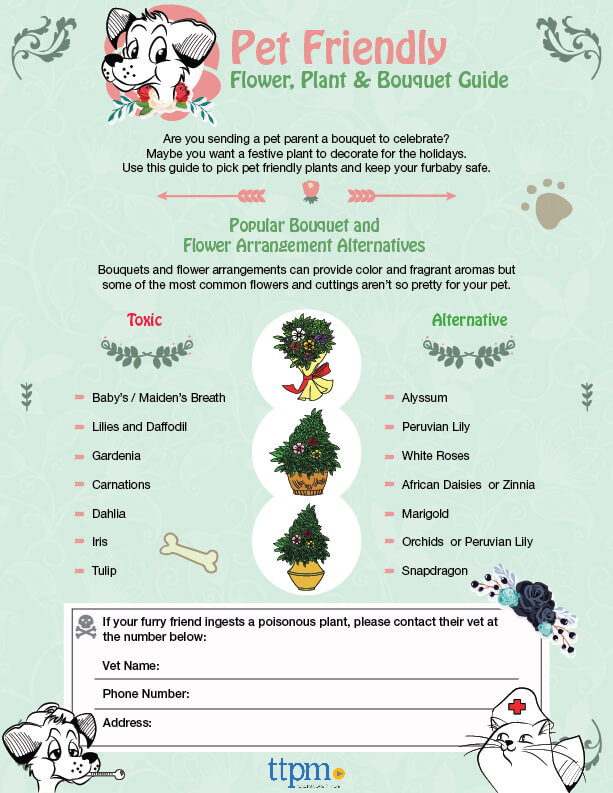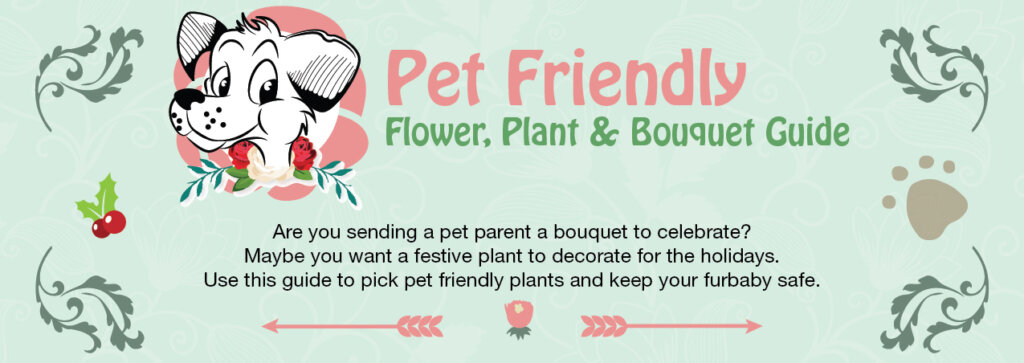Whether you’re a pet parent looking for some flowers to brighten up your home, or you’re sending a gift to someone with a dog or cat that loves to chew everything, it is important to know which flowers and fillers are safe for cats and dogs, and which can be toxic. That’s why we created the printable chart below.
Print a copy to bring to the florist or use it as a reference when ordering a bouquet online. It will help you to pick pet-friendly flowers and find stunning substitutes to make sure the recipient is happy and their furbabies are safe.

Use the code below to share this “pet-friendly” printable on your website or blog:
Pet Safe Flowers and Plants:
Looking for which flowers are poisonous for pets and what you can substitute to keep them safe? We carefully constructed the list below to help make finding flowers that won’t hurt your dog or cat easy. Each type of flower below has been evaluated and sourced so you can find more information about each.
| Toxic Flower | Alternative |
|---|---|
| Baby’s / Maiden’s Breath ***** | Alyssum * |
| Lilies and Daffodil * | Peruvian Lily * |
| Gardenia ***** | White Roses * |
| Carnations ***** | African Daisies * or Zinnia ***** |
| Dahlia ***** | Marigold ***** |
| Iris ***** | Orchids * or Peruvian Lily * |
| Tulip ** | Snapdragon * |
Even when you buy pet safe flowers, its important to take a couple more steps to help keep your pets safe. Remember, plants may have been treated with toxic chemicals while they were grown or right before shipping to keep them fresh. They have also been through trucks, trains, planes, etc… and can pick up other things which might not be healthy for your furry friends. That’s why we recommend the following additional precautions before you place plants within their reach.
Once you get the flowers and fillers home, rinse them thoroughly to help wash off any excess chemicals, pesticides or residue left over from where they are grown and when they were shipped. Next, find pet friendly alternatives to the chemicals provided by the florist that make the flowers last longer. This is important if your playful pup or curious kitty end up knocking the vase over. You don’t want them drinking the water that has the preservative chemicals.
It also never hurts to print and keep a chart like the one above with your vets information filled out. This way if your dog or cat starts acting weird after eating a plant or in general, the person watching after them will know exactly who to call in case of emergencies. You can also talk to your vet and florist for more pet safe flower and plant options if you have a specific style or theme you’re looking for.
As always, don’t forget to check out our dog toy reviews and also find something fun for your frisky feline with our video cat toy reviews including scratchers, teasers and feathers.
Sources:
*http://www.teleflora.com/floral-facts/pet-friendly-plants-flowers
**http://familypet.com/during-the-holidays-i-want-to-protect-my-cat-what-are-some-safe-alternatives-to-candles-with-wick-tinsel-and-real-poinsettias/
***http://www.petmd.com/dog/seasonal/evr_multi_dangerous_winter_holiday_plants
****https://animalwellnessmagazine.com/toxic-holiday-plants
*****https://www.aspca.org/pet-care/animal-poison-control/toxic-and-non-toxic-plants

